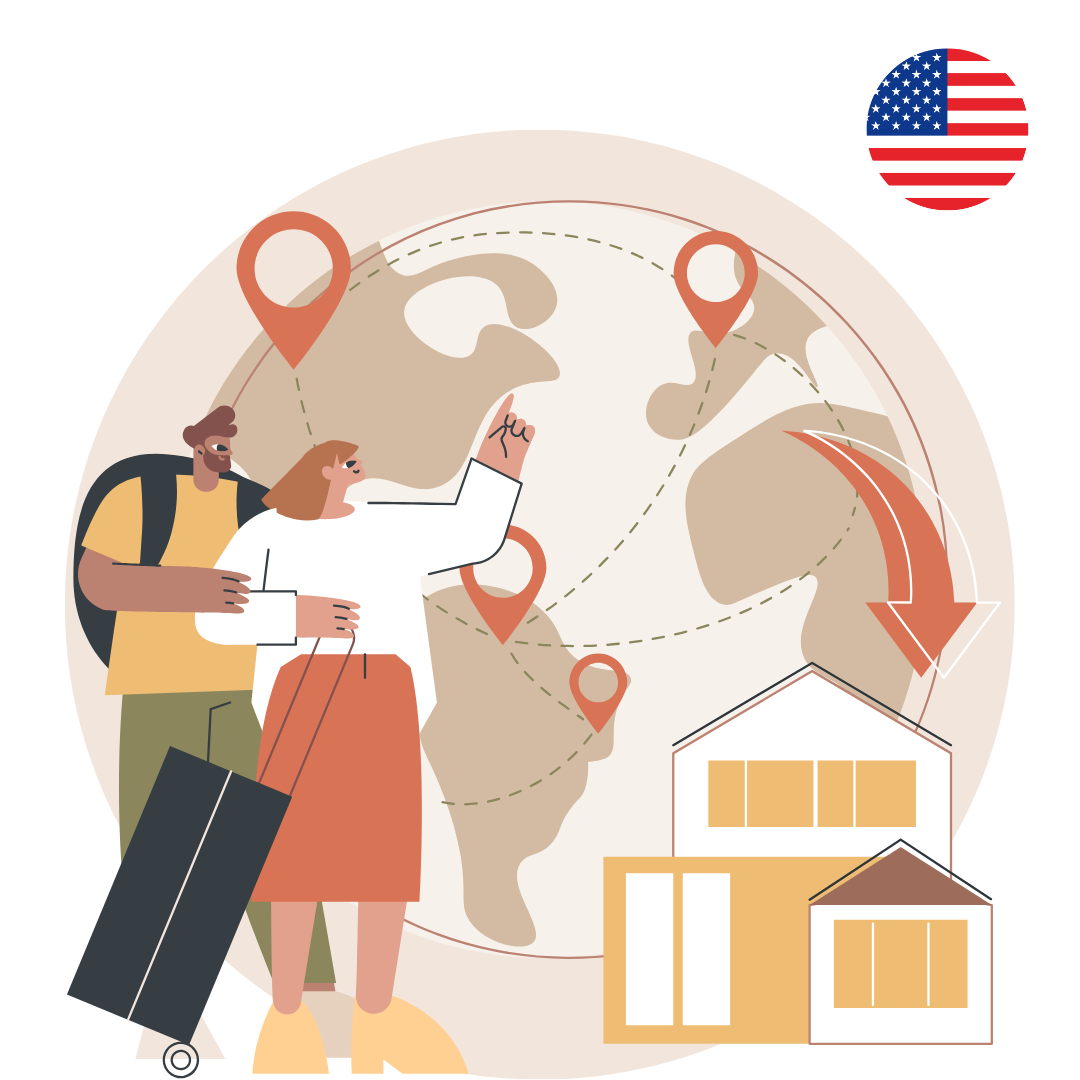many international students choose the United States for its modern education system and high-quality standards. However, due to the relatively high cost of living in the country, they often take up part-time student jobs to manage their studies and personal life.
A U.S. student visa allows students to work up to 20 hours per week. During university holidays, they can work full-time, up to 40 hours per week.
With an F-1 visa, you can work in the U.S. on a limited basis. To begin this process, you must first inform your Designated School Official (DSO). Failing to inform your DSO may lead to serious consequences, including being expelled from the U.S. and being barred from reentry.
In the U.S., depending on a student’s academic program, there are two types of student employment:
- On-campus jobs
- Off-campus jobs
By taking up student jobs in the U.S., you can easily cover your educational expenses. Snap Study Institute’s experts are available to guide you on student jobs in the USA.
Student Employment Conditions
given the high costs of living and studying in the U.S., the most suitable option for international students is to take on part-time jobs to help reduce and cover expenses. To start working as a student, you must first obtain a student visa and submit your request to the appropriate university official. Students with F-1 or M-1 visas must work on campus during their first year of study.
General conditions for student employment in the U.S. include:
- Possession of a valid student visa
- Availability of free time for part-time work
- Coordination with academic courses and schedules
- Proof of financial need
- Completion of relevant forms and submission of a work request
- A maximum of 20 working hours per week during the academic term
- Awareness that American students are given hiring priority
If eligible, you may work either on or off campus. The latest conditions for student jobs in the U.S. can be provided by Snap Study Institute’s advisors.
Student Employment
One type of student job in U.S. universities is working at the university itself. According to student work regulations, you can work 20 hours per week during the academic term and full-time during holidays. On-campus jobs are the easiest and most effective way for students to earn income to cover living expenses.
Students with F-1 visas can submit a request for student employment to the relevant university official (DSO) and be informed about available jobs. This request must be submitted no later than 30 days before classes begin. Once the request is approved, a confirmation letter will be provided to the student. Additionally, the student will receive another letter from the university employer to apply for a Social Security Number (SSN), which is mandatory for part-time work in the U.S.
Examples of student jobs at U.S. universities include working in the university bookstore, cafeteria, publications, or creating content for the university’s website. For guidance on how to apply for student jobs and learn about other university jobs, contact Snap Study Institute’s advisors.
Student Employment outside U.S. Universities
Apart from on-campus jobs, students can work off-campus part-time under certain conditions. This option is available only to students who have completed at least one academic year in the U.S. These students can visit their DSO, explain their financial difficulties, and receive approval for part-time off-campus work.
The DSO will provide a recommendation letter along with Form I-20, titled “Certificate of Eligibility for Nonimmigrant Status,” which the student can present to their potential employer. After receiving Form I-20, the student will submit Form I-765, titled “Application for Employment Authorization,” to USCIS within 30 days of the recommendation. If USCIS approves the request, they will send Form I-766, titled “Employment Authorization Document” (EAD), specifying the approved work periods. Until the forms are approved by USCIS, students are not allowed to start working.
Snap Study Institute’s advisors can help you navigate this process, as even a small mistake could lead to deportation from the U.S.!
Income from Student
The U.S. is one of the largest and most advanced countries in the world, with a relatively high cost of living, making it particularly challenging for international students. These costs include tuition, textbooks, accommodation, daily meals, clothing, transportation, social services, and recreational activities. These factors depend on the state, lifestyle, university, and other elements. On average, living costs are approximately $1,000 to $1,500 per month.
In the U.S., income also depends on one’s level of expertise. The minimum income for individuals without work experience is around $26,000, while those with experience may earn about $65,000 annually.
Income from student and part-time jobs in the U.S. varies by state, university, and job type. On average, students can earn around $17 per hour and approximately $340 per week. The minimum annual income for students is about $6,000 to $7,000.
For the most up-to-date and accurate information on student job income in the U.S., consult Snap Study Institute’s advisors.
Best Student Jobs
Student jobs in the U.S. are divided into on-campus and off-campus categories. Jobs that offer sufficient income to cover study and living expenses are generally more popular.
Examples of on-campus jobs in the U.S. include working in the university cafeteria, publications, website content creation, and designing and formatting university publications and magazines.
Students who have completed one year of study in the U.S. and are facing financial difficulties can present their case to the relevant university official and obtain approval to work off-campus.
Here are some of the most financially viable jobs with the highest student employment rates in the U.S.:
- Administrative Assistant
- Marketing Specialist
- Graphic Designer
- Data Analyst
- Accountant
- Human Resources Specialist
- Operations Manager
- IT Specialist
- Web Engineer
- Tutor
- Farm Intern
For up-to-date information on student jobs and their income, consult Snap Study Institute’s advisors.
Documents for Student Employment
To obtain a work permit in the U.S., often referred to as an Employment Authorization Document (EAD), you must have the necessary documents and meet the requirements for student employment. These requirements vary depending on individual circumstances and visa status. However, some general requirements and documents include:
- A valid student visa: To obtain a work permit in the U.S., you must have a valid student visa such as an F-1 visa or J-1 (exchange visitor) visa.
- Enrollment in the admitted university: You must be enrolled in the university where you were accepted.
- Maintaining student status: You must maintain your status as a student.
- Student employment application documents: The process of obtaining a work permit in the U.S. typically includes filling out Form I-765 and applying for employment authorization from USCIS as a student.
- Employment authorization confirmation: If your application is approved, you will receive an EAD specifying the period during which you are allowed to work as a student in the U.S.
Finding Student Jobs
Finding a job as a student in the U.S. can be a multifaceted and challenging process. Here are some steps to help you find a student job in the U.S.:
- University Counseling: Many universities have offices dedicated to introducing job opportunities to students, specifically to help them find part-time or temporary work both on and off campus. These offices often offer services such as job posting searches, resume preparation assistance, and interview preparation.
- Use of Job Posting Websites: Websites like Indeed, Glassdoor, LinkedIn, and CareerBuilder introduce job opportunities to students in various companies and cities. You can filter your search on these sites based on your preferences, such as part-time, temporary, or student-friendly jobs.
- Finding Student Jobs on Campus: Many universities and colleges offer on-campus job opportunities for students. These jobs may include working in the library, student center, or administrative offices.
- Using the International Student Network: Another effective way to find a job in this advanced country is to utilize the network of international students. Don’t overlook the importance of connecting with other students and leveraging their network of friends.
By following these steps and actively searching for jobs, you can increase your chances of finding a suitable job as a student in the U.S.
Working Hours
working hours in student jobs in the U.S. are usually regulated by visa restrictions and students’ academic needs. Here are some key points regarding working hours in student jobs in the U.S.:
- Visa Restrictions: Under student visa regulations, international students usually face restrictions on working hours. For example, F-1 students are typically allowed to work part-time (up to 20 hours per week) during the academic term. They can work full-time during summer and other academic breaks.
- Academic Needs: Working hours may vary based on students’ academic requirements. Some universities may impose specific restrictions, such as recommending or requiring part-time work during the academic term.
- Working Hours during Academic Term and Holidays: Some students prefer to limit their working hours during the academic term and work more during holidays to focus more on their studies.
Overall, students seeking employment in the U.S. must align their working hours with visa restrictions, academic needs, and job conditions. It’s important to discuss these points with your employer or direct supervisor when accepting a student job.
For more detailed information on this topic, consult Snap Study Institute’s advisors to find the best path forward.
Student Job Wages
Student job wages in the U.S. vary depending on the type of work, location, working hours, and student experience. Here are some points regarding student job wages in the U.S.:
- Average Wage for Student Jobs: The average hourly wage for students working in the U.S. varies based on the industry, job type, and location. However, hourly wages typically range from $8 to $20.
- Salary and Income Based on Type of Work: Some student jobs pay more than others based on the job’s skill level and the student’s experience. For example, jobs in IT and technical fields generally offer higher salaries, while administrative or service jobs may have lower hourly wages.
- Salary Determination Based on Location: Wages also vary by state and city. States and cities with higher costs of living, such as New York City, San Francisco, and Washington, D.C., often offer higher wages to match living costs. However, this doesn’t mean that all student jobs offer high wages in those areas.
Students can explore the job market and choose the best opportunities by considering these points and thoroughly researching their options.
Taxation of Student Jobs
Taxation of student jobs in the U.S. is an important aspect of the income earned by international students, and it’s essential to comply with tax regulations. Here are some key points regarding the taxation of student jobs in the U.S.:
- Taxation of Income Earned from Student Jobs: International students working in the U.S. must report their income and may be subject to federal, state, and local taxes. Tax withholding on income earned from student jobs usually depends on the individual’s tax status and residency.
- Tax Forms and Filing Requirements: International students must file appropriate tax forms and submit a tax return annually. The most common form for students is Form 1040NR or 1040NR-EZ, which is used for non-resident aliens. It’s crucial to complete and submit the required tax forms to comply with U.S. tax regulations.
- Exemption from Certain Taxes: International students with specific visas, such as the F-1 or J-1 visa, may be exempt from paying certain taxes, such as Social Security and Medicare taxes, during their time of study. However, this exemption is usually limited to the duration of their studies and may change after graduation.
It’s essential for international students to be aware of the tax regulations applicable to their jobs and to file taxes in compliance with U.S. tax laws. For more detailed information on tax regulations and procedures for filing tax returns, you can consult Snap Study Institute’s advisors.
Off-Campus Work
In the U.S., there are various off-campus work opportunities for students, allowing them to work part-time while gaining valuable experience. However, off-campus work typically requires a work permit and must comply with U.S. immigration regulations. Here are some points regarding off-campus work opportunities for students in the U.S.:
- OPT (Optional Practical Training): OPT allows students on F-1 visas to work off-campus in their field of study. This program provides the opportunity to gain practical experience related to the student’s major for up to 12 months (or up to 36 months for STEM majors).
- CPT (Curricular Practical Training): CPT enables F-1 students to participate in internships, cooperative education programs, or other work experiences directly related to their field of study. CPT is a part of the academic curriculum and can be done during or after the academic program.
- Pre-Completion and Post-Completion OPT: OPT can be divided into pre-completion (work during the academic term) and post-completion (work after graduation). Students are advised to carefully plan their OPT periods to maximize their opportunities.
- Economic Hardship Work Authorization: In certain cases, students may apply for off-campus work authorization due to severe economic hardship, which must be documented and approved by USCIS.
- Internship Opportunities: Off-campus internships are another way for students to gain practical experience and build their resumes. Students must ensure that their internships comply with immigration regulations and may require authorization if the internship is unpaid.
Students can explore these off-campus work opportunities to gain experience and enhance their professional skills while studying in the U.S.
Conclusion
In summary, working as a student in the U.S. is a great way to manage expenses while gaining valuable work experience. By understanding visa regulations, working conditions, and employment opportunities, students can find the right job to support their education and future career. For more detailed guidance and the latest updates, SnappStudy Institute’s advisors are always ready to assist.




